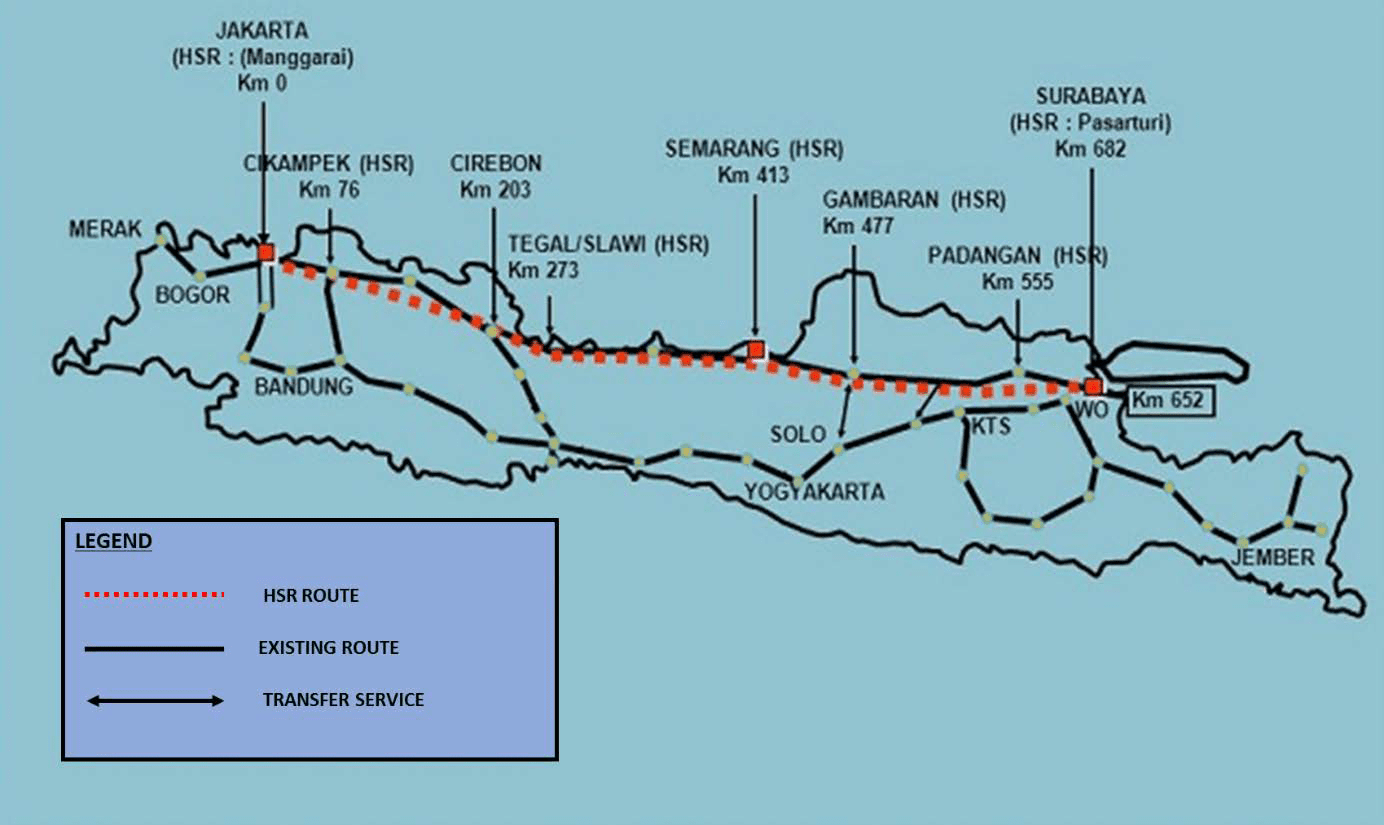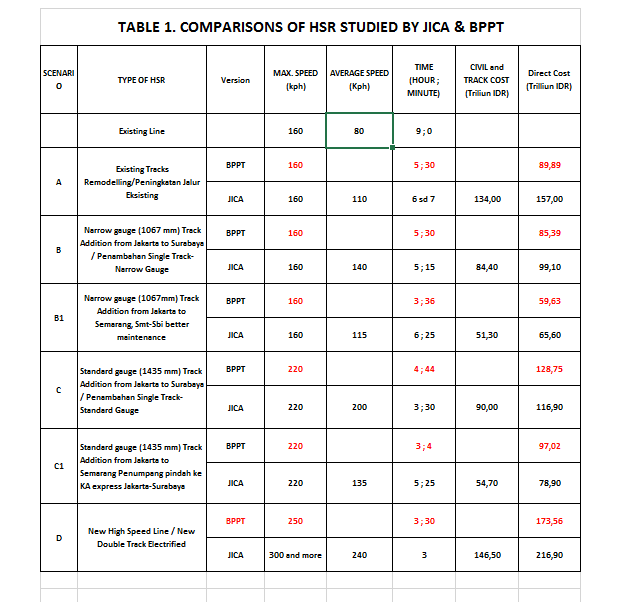Highspeed train is getting its popularity more, as an effective long distance transport mode, in many modern cities and countries. High-speed rail (HSR) is a type of rail transport that operates significantly faster than traditional rail traffic, using an integrated system of specialized rolling stock and dedicated tracks. While there is no single standard that applies worldwide, new lines in excess of 250 kilometres per hour (160 mph) and existing lines in excess of 200 kilometres per hour (120 mph) are widely considered to be highspeed, with some extending the definition to include lower speeds in areas for which these speeds still represent significant improvements. The first such system began operations in Japan in 1964, namely Shinkansen, and was widely known as the bullet train. High-speed rail normally operate on standard gauge tracks of continuously welded rail on grade-separated right-of-way that incorporates a large turning radius in its design (ref; Wikipedia).
Indonesia is an archipelago with thousands of islands and more than 240 million of population. Economy of the country is also growing of above 5% annualy, giving confidence of future growth and development, and even economy distribution across the country for national prosperity. Connectivities among the islands are inevitable needs to achieve equality of economic development. Transportation modes such air transport, sea/water transport and land transport have developed in the country and are necessary to maintain such connectivities including the ICT connectivites. For more aggressive connectivity, sea-toll was once announced as major transport development for Indonesian archipelago.
To complete these connectivities, Indonesia is also looking at HSR as an option just like many other countries that have developed high-speed train to connect major cities, including Austria, Belgium, China, France, Germany, Italy, Japan, the Netherlands, Poland, Portugal, Russia, South Korea, Spain, Sweden, Taiwan, Turkey, the United Kingdom, the United States and Uzbekistan. Only in Europe does HSR cross international borders. China has 22,000 kilometres (14,000 mi) of HSR as of end December 2016, accounting for two-thirds of the world's total. Indonesia is now at the beginning phase of HSR development. It has indeed started since the era of President Susilo Bambang Yudhoyono’s era, with the study undertaken by Bappenas (government agency for national planning and development), Ministry of Transport and BPPT (national agency for research and implementation of technology), being supported by JICA (Japan International Cooperation Agency). The study looked at the connectivity of two big cities in Java island namely Jakarta and Surabaya considered end-to-end of the island, then also at smaller scale looked at the possibility connecting Jakarta and Bandung of Java island.
Surely there have been connectivities of those two cities of any modes such as air, sea and land transport, however for more effective connectivity to speed up the economic growth might have to look at different technology and mode. HSR could be considered to put virtuil trajectory of air transport on the ground, so more city connectivities can be made instead of only Jakarta and Bandung or Surabaya alone.
To such extent more economic developments in cities connected become more plausible. For example, instead of only having Jakarta-Surabaya connectivity by air transport, some cities of Jakarta, Cikampek, Cirebon/Tegal, Semarang, Gambaran, Padangan and Surabaya can be connected by HSR with reasonably short travel time. Furthermore, see Figure 1 and Table 1 as comparison of studies made by JICA and BPPT.
Similar studies have been made also for Jakarta-Bandung connectivity with HSR by Japanese and then Chinese government of 150 km length. Looking at recent cases, the Indonesian government is seeking more for B2B funding as G2G funding scheme appears take longer time to proceed with higher cost compared to that of B2B. Therefore, it was appropriate for the Indonesian government to ask the Chinese government for cooperation that came up aggressively with B2B basis instead of the Japanese government scheme with its G2G basis. In September 2015 Indonesian government had agreed on the cooperation of 150 km HSR with operating speed of 200 to 250 km/h connecting Jakarta-Bandung. The project is undertaken by joint venture company of PT Kereta Cepat Indonesia Cina ( PT KCIC) with share composition of 60% owned by PT Pilar Sinergi BUMN Indonesia ( PT PSBI) and of 40% owned by China Railway International (CRI).This HSR may connect several stations like Halim Perdana

FIGURE 1. HSR JAKARTA – SURABAYA
Kusuma (in Jakarta), Cikarang, Karawang, Walini and Gedebage (in Bandung), with depo located in Karawang. In spite of land acquisition problems faced Jakarta-Bandung HSR project is still undertaking since the 21 st January 2016 ground-breaking.

TABLE 1. COMPARISONS OF HSR STUDIED BY JICA & BPPT
Despite the pro’s and con’s of HSR development in the country, there is a need to comprehend the system, and its relation not only as modern transport mode but also to socio-economy development, even further to the aspects of finance and safety considered very crucial for sustainability. Moving people with modern technology like HSR in Indonesia is efficient, though to have HSR as reliable, safe, economical and financially viable mode is guaranteed for its sustainability. High cost of investment as well as operation and maitenance is to be compensated, and it might comprise the farebox revenue, public service obligation and other non-farebox revenue such as commercials. Changing life-style is another issue that may be raised to make use of HSR aside of its connectivity to local transport or seamless city transport. Needless to say that discussion on TOD (transit oriented development) follows the development concept of HSR, just like any other mass transit systems.
So HSR has already entered a new era of transport mode in Indonesia, however, there are still a lot of aspects to learn to let HSR become sustainable and to be backbone of economy in the country as expected.
